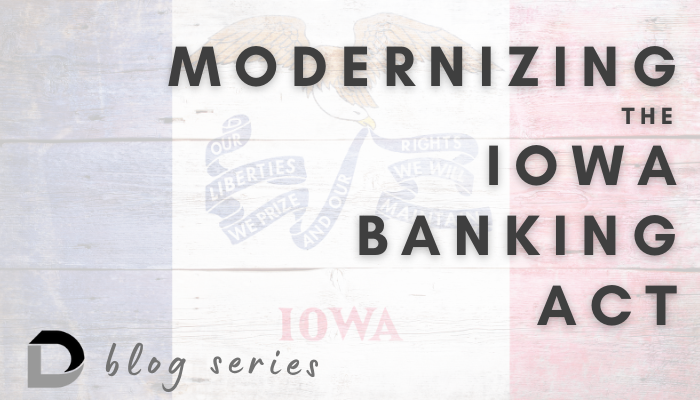Did Iowa’s Lending Limit Get Easier to Understand?

Posted on 08/26/2022 at 01:52 PM by John Lande
On July 1, the most significant change to the legal landscape for Iowa banks in a generation occurred when new amendments to Iowa Code Chapter 524 became effective. For the next several weeks, Dickinson Law will cover some of the most significant changes and how they affect Iowa banks.
Iowa Code 524.904, which imposes a limit on lending to individual borrowers, has been a source of confusion for banks and borrowers. Recent amendments to Iowa’s banking law sought to clarify the law without changing the substantive provisions. The amendments may simplify the law, but complexities and uncertainties in its application remain.
As it was before the amendments, the state lending limit essentially limits a bank’s lending to an individual borrower to 15% or 25%, depending on the circumstances, of aggregate capital. Aggregate capital is defined as “capital, surplus, undivided profits, and reserves as of the most recent calculation date.”
The amendments eliminated language that arguably allowed for a higher threshold in certain circumstances. In practice, the requirements for the higher threshold were never met. For example, one exception applied only to loans secured by things such as “nonnegotiable bills of lading, warehouse receipts, or other documents transferring or securing title covering readily marketable nonperishable staples . . . .”
The amendments to the lending limit make it easier to understand what the limit is for particular borrowers. The amendments did not make substantive changes to the lending limit section, which means that certain ambiguities remain.
For example, left unchanged are the definitions of what constitutes “one borrower.” Iowa Code 524.904(5)(b)(1) states:
b. For the purposes of this subsection, a borrowing group includes a person and any legal entity, including but not limited to corporations, limited liability companies, partnerships, trusts, and associations where the following exist:
(1) One or more persons own or control fifty percent or more of the voting securities or membership interests of the borrowing entity or a member of the group.
The application of this provision to, for example, limited partnerships or LLCs with common members or owners remains ambiguous. Given the variety of ways that developers and businesses structure their operations, this can create questions about whether particular entities are considered members of a group.
If a bank encounters more complex entity structures, attention should be given to whether the collection of entities crosses the borrower group threshold identified above. It can be easier to address potential violations of this provision when structuring financing at the beginning of the relationship, and avoid being forced to participate or restructure loans for a significant customer.
Looking for a "Window of Opportunity"?
The attorneys at Dickinson Law are creating some great presentations on the issues that banks are facing for the 2022 Banking Law Seminar on September 8th. An agenda has just been released -- check out this year's session topics and register here.
Categories: John Lande, Banking Law
Questions, Contact us today.
The material, whether written or oral (including videos) that is posted on the various blogs of Dickinson Bradshaw is not intended, nor should it be construed or relied upon, as legal advice. The opinions expressed in the various blog posting are those of the individual author, they may not reflect the opinions of the firm. Your use of the Dickinson Bradshaw blog postings does NOT create an attorney-client relationship between you and Dickinson, Bradshaw, Fowler & Hagen, P.C. or any of its attorneys. If specific legal information is needed, please retain and consult with an attorney of your own selection.







